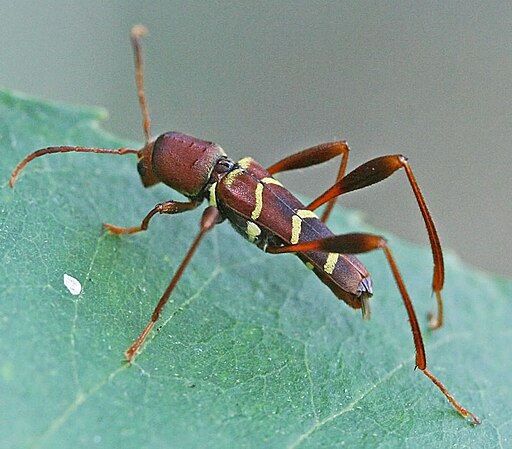Superregnum: Eukaryota
Cladus: Unikonta
Cladus: Opisthokonta
Cladus: Holozoa
Regnum: Animalia
Subregnum: Eumetazoa
Cladus: Bilateria
Cladus: Nephrozoa
Cladus: Protostomia
Cladus: Ecdysozoa
Cladus: Panarthropoda
Phylum: Arthropoda
Subphylum: Hexapoda
Classis: Insecta
Cladus: Dicondylia
Subclassis: Pterygota
Cladus: Metapterygota
Infraclassis: Neoptera
Cladus: Eumetabola
Cladus: Endopterygota
Superordo: Coleopterida
Ordo: Coleoptera
Subordo: Polyphaga
Infraordo: Cucujiformia
Cladus: Phytophaga
Superfamilia: Chrysomeloidea
Familia: Cerambycidae
Subfamilia: Cerambycinae
Tribus: Clytini
Genus: Neoclytus
Species: Neoclytus acuminatus
Subspecies: N. a. acuminatus – N. a. hesperus
Name
Neoclytus acuminatus (Fabricius, 1775)
References
Original reference
Fabricius, J.C. 1775: Systema Entomologiae, sistens insectorum classes, ordines, genera, species... Flensburgh and Leipzig, Library Kortii. Internet Archive BHL
Links
BHL bibliography
Hassler, M. {{{1}}}. Neoclytus acuminatus. World Plants: Synonymic Checklists of the Vascular Plants of the World In: Roskovh, Y., Abucay, L., Orrell, T., Nicolson, D., Bailly, N., Kirk, P., Bourgoin, T., DeWalt, R.E., Decock, W., De Wever, A., Nieukerken, E. van, Zarucchi, J. & Penev, L., eds. {{{1}}}. Species 2000 & ITIS Catalogue of Life. Published online. Accessed: {{{1}}} {{{2}}} {{{3}}}. Reference page.
Neoclytus acuminatus – Taxon details on Encyclopedia of Life (EOL).
Global Biodiversity Information Facility. 2019. GBIF Backbone Taxonomy. Checklist dataset. Taxon: Neoclytus acuminatus.
ION
Cerambycidae of the World.
Neoclytus acuminatus, the red-headed ash borer, is a common North American species in the longhorn beetle family (Cerambycidae).
Description and ecology
Red-headed ash borers typically reach 12–16 mm (0.47–0.63 in) adult length, have long antennae which are thickened towards the tips, and have the rear and middle pairs of legs elongated. The reddish-brown coloration with four bands of contrasting yellow stripes and the general body shape mimics wasps, which is a common survival tactic among cerambycids.
Adults emerge from infested trees in early spring, typically ash, hickory and oak, but also use other hardwoods and sometimes shrubs and woody vines. The larvae feed on the sapwood of dead trees, with several generations possible over the summer before overwintering again, probably in the pupal stage.
Significance
The red-headed ash borer usually develops in recently dead or dying hardwood trees, so the most common impact on humans is damage to felled trees intended for hardwood lumber or firewood. These insects are commonly brought into homes with firewood and may emerge, but do no physical damage to the home. This species has been known to infest weak or newly planted living trees and is a pest of nursery stock in some areas. The feeding of the larvae may cut off sap flow, and in some cases weaken the trunk of young trees making them more susceptible to wind damage.
In natural settings, red-headed ash borers contribute to healthy forests by hastening the decomposition of dead and dying timber, making more nutrients and space available for healthy plants.
Red-Headed Ash Borer (Neoclytus acuminatus) mating pair
References
Ross H. Arnett, Jr.; C. Thomas; P. E. Skelley; J. H. Frank (eds.). Polyphaga: Scarabaeoidea through Curculionoidea. American Beetles. Vol. II.
Elizabeth S. Dillon; Lawrence Dillon. A Manual of Common Beetles of Eastern North America.
Retrieved from "http://en.wikipedia.org/"
All text is available under the terms of the GNU Free Documentation License


